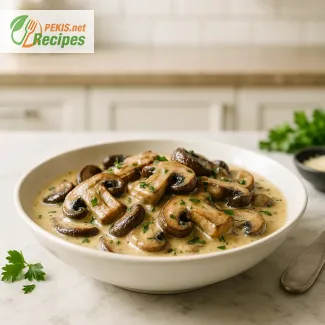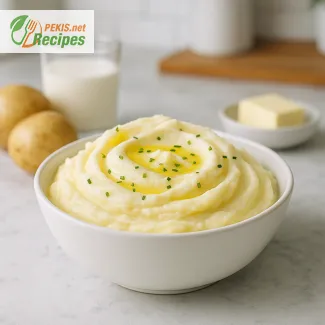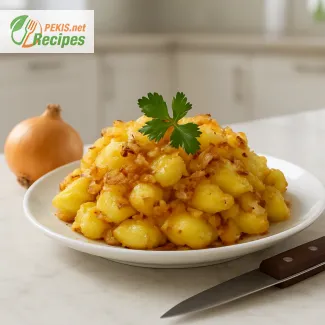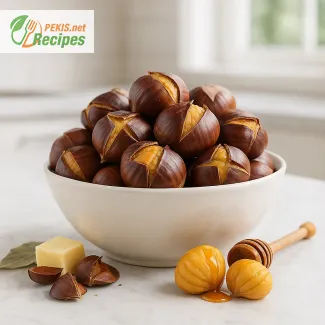A jar of fermented cabbage with garlic and carrot brings a bright, tangy crunch that feels both rustic and refreshing. Crisp cabbage, mellow garlic and sweet carrot ferment slowly into a lively, probiotic mix with deep roots in traditional winter preservation. Each bite is juicy, vibrant and gently supportive for daily digestion.
Brining cabbage until it releases its own crisp–tender magic is a small technique that transforms simple vegetables into something deeply flavorful. Letting garlic mellow and carrot sweeten through slow fermentation creates balance without extra effort. PEKIS – professional chef and recipe developer with over 25 years of experience in cooking and baking, specialized in European and international cuisine.
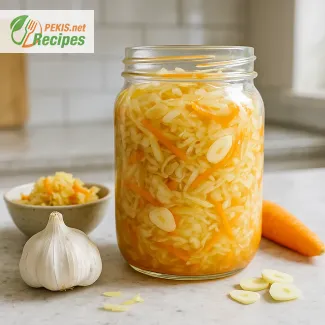
Slow-fermented cabbage with garlic and carrot for everyday gut comfort
A crunchy, tangy fermented cabbage side with garlic depth and carrot sweetness to gently support daily digestion
When a jar of fermented cabbage is opened and that first tangy, slightly salty aroma escapes, the whole kitchen shifts. Shredded cabbage still holds a pleasant crunch, garlic brings a warm, savoury note, and thin strands of carrot add natural sweetness and colour. Together they create a side dish that feels both rustic and refined: the kind of food that sits quietly on the table, yet keeps drawing the fork back with its refreshing acidity and light, clean finish that leaves the stomach feeling comfortably settled rather than heavy.
In this recipe, finely sliced cabbage is gently massaged with salt until it begins to release its own brine, then layered with thin carrot sticks or shreds and slivers of fresh garlic. Over days, natural lactic acid bacteria transform the vegetables into a probiotic ferment: the brine turns cloudy, flavours deepen, and each bite becomes a lively balance of sour, savory and faintly sweet vegetable notes. Unlike overly soft store-bought versions, this homemade style keeps the cabbage firm yet yielding, with carrots that stay pleasantly snappy instead of mushy.
Across Central and Eastern Europe, variations of sauerkraut with added vegetables have been part of winter survival for centuries. Cabbage, garlic and carrot are pantry staples in many Slovenian, German, Polish and Balkan kitchens, preserved in wooden barrels or large glass jars to bridge the gap between seasons. The combination was never meant to be fancy; it was about keeping families nourished when fresh produce was scarce. Today, this same simple trio fits perfectly into modern interest in gut health, fermented foods and traditional techniques that respect the ingredient rather than hiding it behind heavy sauces.
How fermented cabbage, garlic and carrot work together
Each element in this ferment plays a distinct role in both flavour and feel:
- Cabbage brings bulk, natural sugars for fermentation and that characteristic crisp–tender texture.
- Garlic adds subtle heat and deep savory aroma that infuses the brine without overpowering.
- Carrot delivers gentle sweetness, extra crunch and a bright orange contrast to pale cabbage ribbons.
- Salt draws out moisture, creates the protective brine and keeps textures pleasantly firm instead of soggy.
As the brine slowly develops, sharp raw garlic mellows, cabbage loses its raw harshness, and carrot sweetness becomes more defined. The result is a jar where every forkful tastes slightly different – one bite more garlicky, the next sweeter with carrot, but all tied together by a clean, lactic acidity that feels light on the stomach.
For those who love building full meals around fermented vegetables, there is also a dedicated recipe for High-Protein Fermented Veggie Bowls with Summer Produce for Gut Health, where similar flavours are combined into a complete, satisfying bowl.
Traditional roots and modern gut-health focus
Fermented cabbage has long been a way to store harvests and add brightness to hearty dishes like stews, potatoes and roasted meats. Garlic and carrot slipped in as flavour enhancers and extra nutrition, turning simple cabbage into something more nuanced.
Today, this style of fermented cabbage with garlic and carrot is often enjoyed as:
- a small side on the plate next to grilled or roasted dishes
- a fresh, tangy topping in warm grain bowls
- a crunchy layer in sandwiches, wraps or savoury pancakes
- a spoonful snack straight from the jar for a quick probiotic boost
If you are curious about other traditional ferments with a focus on digestive comfort, you can explore Fermented Potato Pulp Tocosh – Ancient Peruvian Remedy for Gut Health, which shows a very different ingredient transformed by similar fermentation principles.
Fermented cabbage, garlic and carrot as a daily gut-friendly habit
Building a small portion of this ferment into everyday meals can become an easy ritual: a spoonful with breakfast eggs, a side next to a simple soup, or a topping on a hearty salad. The bright acidity wakes up the palate, while the mild garlic warmth and crunchy carrot prevent it from feeling monotonous. Because the flavours are balanced rather than aggressively sour, it suits those who want gentle support for digestion without overly intense, vinegary ferments.
Why you’ll love this fermented cabbage with garlic and carrot
- Gentle on digestion – light, refreshing acidity that feels supportive rather than heavy.
- Balanced flavour – tangy, lightly garlicky, with a hint of carrot sweetness.
- Versatile use – works as a side, topping or component in bowls and sandwiches.
- Simple ingredients – everyday vegetables turned into something special with time and salt.
- Make-once, enjoy-often – a single batch can accompany many different meals.
Storage and make-ahead for busy weeks
Once the desired level of sourness is reached, the jar keeps well in the refrigerator for several weeks, sometimes even longer if handled cleanly. The texture stays crisp when the cabbage is tightly packed and always submerged under brine. This makes the ferment ideal for meal prep: one fermentation session provides a ready-to-serve, flavour-packed side that waits in the fridge and can be added to meals in seconds.
- Store in a glass jar with a tight-fitting lid.
- Keep vegetables covered by brine to maintain quality.
- Use a clean fork or tongs each time to avoid introducing unwanted particles.
Creative variations with fermented cabbage, garlic and carrot
Once the base version feels familiar, small adjustments can keep the jar exciting:
- Spice warmth – add a few peppercorns, a bay leaf or a pinch of chili flakes for a subtle kick.
- Herbal notes – tuck in dill stems, caraway seeds or mustard seeds for more aromatic depth.
- Root vegetable twist – swap part of the carrot for beetroot or parsnip for a different colour and sweetness.
- Texture play – mix finely shredded and slightly thicker cuts of cabbage for more varied crunch.
Each variation keeps the core trio of cabbage, garlic and carrot, preserving the gut-friendly, everyday character of the dish while allowing it to adapt to different seasons, cuisines and personal preferences.
- Place the shredded cabbage into a large bowl and sprinkle the salt evenly over the surface. Massage the cabbage firmly for several minutes until it releases enough liquid to begin forming its own brine.
- Add the carrot and garlic, mixing thoroughly so the vegetables distribute evenly and the flavours integrate.
- Transfer the mixture into a clean glass jar. Press the vegetables down firmly so the brine rises and covers the surface. If necessary, add a small amount of water to ensure all vegetables stay completely submerged.
- Place a weight or small inner jar on top to keep the vegetables below the brine. Close the jar loosely to allow gases to escape.
- Leave the jar at room temperature (20–22 °C / 68–72 °F) for 3–5 days. Check daily that the vegetables remain submerged and press down again if needed.
- When the flavour becomes pleasantly sour with a crisp-tender texture, seal the jar tightly and store it in the refrigerator.
FAQ questionHow long should fermented cabbage with garlic and carrot sit before eating?
Fermented cabbage with garlic and carrot usually needs 3–5 days at room temperature to develop a pleasantly sour flavour and crisp–tender texture. After day 2, start tasting once daily: when the cabbage is tangy but not aggressively sour, and the garlic has mellowed, it is ready to move to the fridge. From there, flavours continue to round out slowly, but the cool temperature stabilises the ferment and keeps the texture from becoming too soft.
FAQ questionWhy does the cabbage need to stay submerged in brine?
Keeping all vegetables completely under the brine is crucial because lactic acid bacteria thrive in this low-oxygen, salty environment, while spoilage microbes prefer air. When cabbage, garlic or carrot float above the liquid, they can develop mould or off-flavours. Pressing the vegetables down, using a fermentation weight and topping up with a little salted water if needed helps maintain a safe, anaerobic environment and ensures a clean, pleasantly lactic acidity.
FAQ questionCan sea salt or iodized salt be used for this ferment?
Non-iodized salt is preferred because iodine and anti-caking agents can slow or disturb fermentation. A pure sea salt or pickling salt lets the natural bacteria work efficiently and keeps the brine clear. Iodized salt will not always ruin a batch, but it may result in softer texture and a less predictable ferment. Sticking to pure, additive-free salt gives better control over flavour, crunch and fermentation speed.
FAQ questionHow can the flavour of fermented cabbage with garlic and carrot be adjusted?
Flavour is easy to tailor by adjusting fermentation time and aromatics. A shorter ferment (3 days) gives a milder, fresher sourness, while a longer one (up to a week) develops deeper tang and complexity. Adding spices such as caraway, peppercorns or chili flakes provides extra aroma and heat. If the ferment tastes too sharp, pair it with creamy elements like yogurt, mashed potatoes or rich meats to balance the acidity and highlight its bright, refreshing notes.
FAQ questionHow is this ferment best served in everyday meals?
Fermented cabbage with garlic and carrot works as a small, flavour-packed side next to grilled meats, stews or roasted vegetables, but also shines as a topping for grain bowls, sandwiches and wraps. A spoonful added to a simple lunch instantly brings crunch, acidity and depth without extra cooking. It can also be stirred into warm dishes right before serving so the cabbage stays crisp and the probiotic character is preserved as much as possible.
FAQ questionWhy is homemade fermented cabbage often better than store-bought versions?
Homemade versions are usually raw, unpasteurised and free from vinegar, which means the acidity comes from natural lactic fermentation rather than added acid. This keeps the texture firmer, the flavours more complex and the brine more nuanced. You can control salt level, garlic intensity, carrot sweetness and fermentation time, adapting the recipe to personal taste and dietary needs. Store-bought options are convenient, but a homemade jar gives a level of freshness, crunch and customisation that is hard to match.
Fermenting cabbage with garlic and carrot turns three everyday ingredients into a reliable source of flavour, crunch and gentle gut support. The slow transformation in brine pulls out natural sweetness, softens raw edges and builds a clean, lactic acidity that brightens almost any plate.
A ready jar in the fridge simplifies daily cooking: a spoonful on the side of warm potatoes, a forkful tucked into a sandwich, a small pile on top of a grain bowl. Each serving adds texture, colour and a refreshing tang without extra work at the stove. Over time it becomes less of a special project and more of a quiet kitchen habit that fits into busy weeks.
The method remains flexible enough for different tastes. Some prefer a milder, shorter ferment, others enjoy a deeper, sharper tang; spices, herbs and other roots can be added without losing the core character of cabbage, garlic and carrot. That balance of structure and freedom makes this ferment easy to return to, season after season.
Kept in a cool place once matured, the jar stays crisp, aromatic and ready to use, encouraging smaller, regular portions rather than occasional heavy servings. In the long run, this steady rhythm of eating fermented vegetables can support a more varied, colourful and digestive-friendly way of eating, anchored in a simple but thoughtfully prepared staple.
Allergens present in the recipe
- None: This recipe contains no major allergens.
- Gluten: None present.
Allergen and gluten substitution advice
- No substitutions required, as the recipe is naturally free from all common allergens and gluten.
- Vitamin C (mg): 32 – supports immune function and tissue repair
- Vitamin K (µg): 62 – contributes to normal blood clotting and bone health
- Potassium (mg): 180 – essential for nerve signalling and fluid balance
- Folate (µg): 38 – important for cell regeneration
- Calcium (mg): 45 – supports bone structure
- Beta-carotene (mg): 1.8 – contributes to skin and eye health
- Flavonoids (mg): 22 – beneficial for cellular protection
- Polyphenols (mg): 30 – assist in reducing oxidative stress

